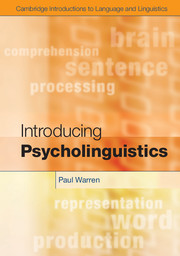Book contents
- Frontmatter
- Contents
- Figures
- Tables
- Preface
- Chapter 1 Introduction
- Chapter 2 Planning utterances
- Chapter 3 Finding words
- Chapter 4 Building words
- Chapter 5 Monitoring and repair
- Chapter 6 The use of gesture
- Chapter 7 Perception for language
- Chapter 8 Spoken word recognition
- Chapter 9 Visual word recognition
- Chapter 10 Syntactic sentence processing
- Chapter 11 Interpreting sentences
- Chapter 12 Making connections
- Chapter 13 Architecture of the language processing system
- Glossary
- References
- Index
Chapter 4 - Building words
Published online by Cambridge University Press: 05 November 2012
- Frontmatter
- Contents
- Figures
- Tables
- Preface
- Chapter 1 Introduction
- Chapter 2 Planning utterances
- Chapter 3 Finding words
- Chapter 4 Building words
- Chapter 5 Monitoring and repair
- Chapter 6 The use of gesture
- Chapter 7 Perception for language
- Chapter 8 Spoken word recognition
- Chapter 9 Visual word recognition
- Chapter 10 Syntactic sentence processing
- Chapter 11 Interpreting sentences
- Chapter 12 Making connections
- Chapter 13 Architecture of the language processing system
- Glossary
- References
- Index
Summary
PREVIEW
This chapter continues our exploration of how we string words together when speaking. We will be looking in particular at how words are constructed from their component parts. You will learn:
that the stored representation of a word contains structural information about its morphology and phonology, including its stress pattern and its syllable and sound structure;
that there are stored representations of sub-lexical (smaller-than-word) units, which are phonetic plans used by the ‘articulator’;
that building words involves the generation of a string of sub-lexical units, based on information associated with each word. The string is then converted into an articulatory plan;
that aspects of this process can become confused, leading to a range of speech errors.
Introduction
The sketch of the lexicalisation process given in Chapter 3 (see Figure 3.1) broke lexicalisation down into two stages – finding words and building words. The process of finding words (lexical selection) was the subject matter of Chapter 3. In this chapter we will look at the process of building words. Again, our evidence will come mainly but not exclusively from speech error data.
- Type
- Chapter
- Information
- Introducing Psycholinguistics , pp. 53 - 70Publisher: Cambridge University PressPrint publication year: 2012

